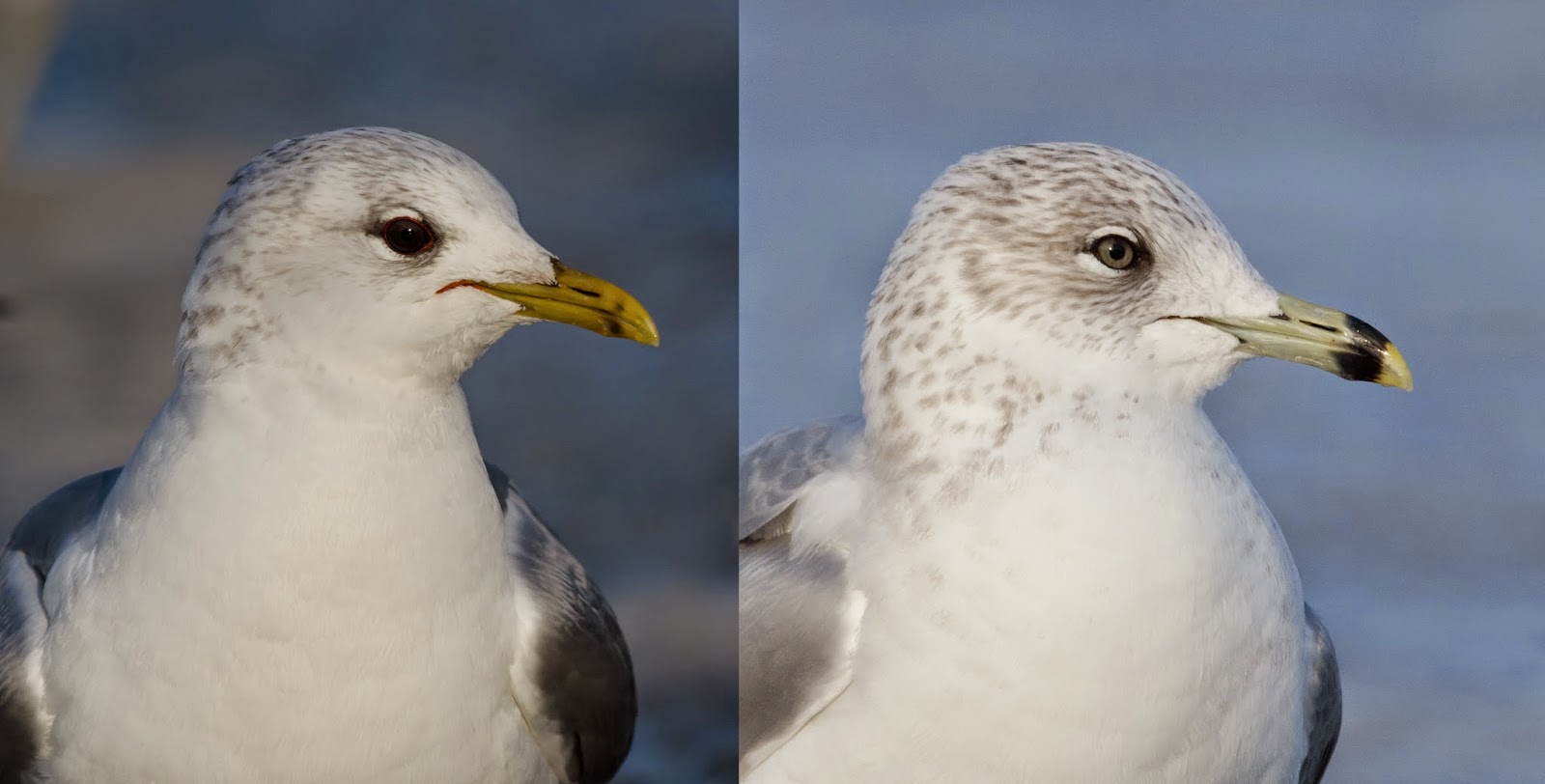The Mew Gull complex (Larus canus) is comprised of four subspecies. The New World representative, referred to as the Mew Gull (L.c. brachyrhynchus), breeds in n.w. North America and winters mainly on the Pacific Coast and is exceptionally rare on the Atlantic Coast during the non-breeding season (one has been confirmed nearby in New Brunswick). The Old World birds are the Common Gull (L. c. canus & L. c. heinei) and the Kamtchatka Gull (L. c. kamtschatschensis). (Howell et al., 2014)
The canus Common Gull is regular in NS in winter in small numbers. The province's first was discovered on March 9, 1969 on Sable Island. (McLaren, 2012)
Analysis of this winter's photos of the canus Common Gulls in the Dartmouth area suggest that there have been 4 individuals. I was able to photograph the gull that was frequenting the Sobeys parking lot on Tacoma Drive in Dartmouth on February 27, 2015 (Fig. 1).
Common Gulls are superficially similar to Ring-billed Gulls. In comparison, a Common Gull has a thinner, less blunt tipped bill that lacks a distinct black ring. Its eyes are dark brown compared to the pale lemon eyes of a Ring-billed as seen in Fig. 2. (Howell et al., 2014)
Common Gulls have a slightly darker mantle that is clear in Figure 3, along with wider and more contrasting scapular and tertial crescents. The wider scapular crescent on the Common Gull is obvious in Figure 3 as well. (Howell et al., 2014)
The relatively more extensive white mirror on P10 of the Common Gull is visible in Fig. 4. (Howell et al., 2014)
The Dartmouth Common Gull was my first Nova Scotian sighting of this bird. I had previously seen Common Gulls in the fjords of Norway in July 2007. Figure 5 shows a number of them with pristine white heads and in the process of moulting their inner primaries. These would also be L.c. canus based on range.
References:
Howell, S.N.G. and J. Dunn. 2007. Gulls of the Americas. Houghton Mifflin Company, New York, N.Y.
McLaren, I.A. 2012. All the Birds of Nova Scotia: status & critical identification. Gaspereau Press Ltd, Kentville, N.S., Canada
The canus Common Gull is regular in NS in winter in small numbers. The province's first was discovered on March 9, 1969 on Sable Island. (McLaren, 2012)
Analysis of this winter's photos of the canus Common Gulls in the Dartmouth area suggest that there have been 4 individuals. I was able to photograph the gull that was frequenting the Sobeys parking lot on Tacoma Drive in Dartmouth on February 27, 2015 (Fig. 1).
 |
| Figure 1. Common Gull in Dartmouth - 27 Feb 2014. Photo by Alix d'Entremont |
Common Gulls are superficially similar to Ring-billed Gulls. In comparison, a Common Gull has a thinner, less blunt tipped bill that lacks a distinct black ring. Its eyes are dark brown compared to the pale lemon eyes of a Ring-billed as seen in Fig. 2. (Howell et al., 2014)
 |
| Figure 2. Common Gull (L) vs. Ring-billed Gull (R). Photo by Alix d'Entremont |
Common Gulls have a slightly darker mantle that is clear in Figure 3, along with wider and more contrasting scapular and tertial crescents. The wider scapular crescent on the Common Gull is obvious in Figure 3 as well. (Howell et al., 2014)
 |
| Figure 3. Common Gull (L) vs. Ring-billed Gull (R). Photo by Alix d'Entremont |
The relatively more extensive white mirror on P10 of the Common Gull is visible in Fig. 4. (Howell et al., 2014)
 |
| Figure 4. Common Gull (L) vs. Ring-billed Gull (R). Photo by Alix d'Entremont |
The Dartmouth Common Gull was my first Nova Scotian sighting of this bird. I had previously seen Common Gulls in the fjords of Norway in July 2007. Figure 5 shows a number of them with pristine white heads and in the process of moulting their inner primaries. These would also be L.c. canus based on range.
 |
| Figure 5. Common Gulls near Flåm, Norway - July 21 2007. Photo by Alix d'Entremont |
References:
Howell, S.N.G. and J. Dunn. 2007. Gulls of the Americas. Houghton Mifflin Company, New York, N.Y.
McLaren, I.A. 2012. All the Birds of Nova Scotia: status & critical identification. Gaspereau Press Ltd, Kentville, N.S., Canada


